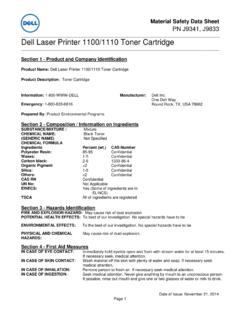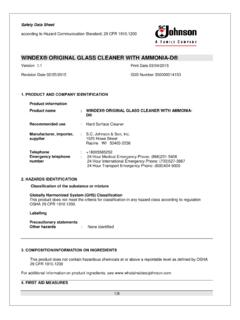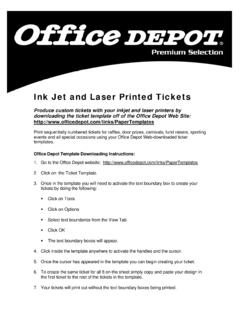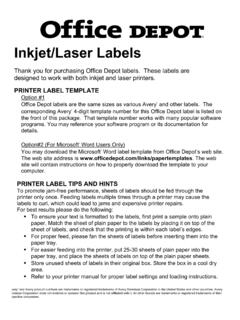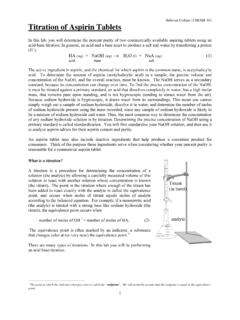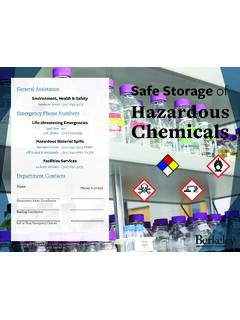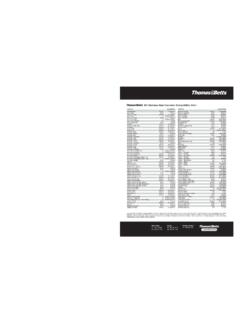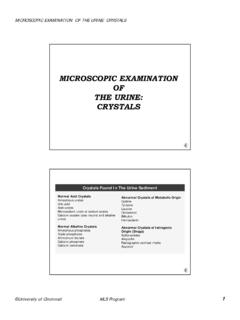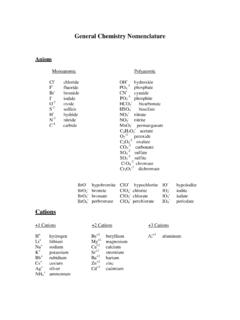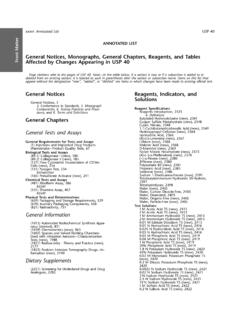Transcription of LITHIUM-ION BATTERY MATERIAL SAFETY DATA SHEET …
1 MATERIAL SAFETY data SHEET LITHIUM-ION BATTERY Effective Date: Jan1, 2014. LITHIUM-ION BATTERY . MATERIAL SAFETY data SHEET (MSDS). SECTION I - MANUFACTURER INFORMATION. Manufactured for: Contact Information: Lenmar Enterprises, Inc. 4035 Via Pescador (US). Camarillo, CA 93012 SECTION II - HAZARDOUS INGREDIENTS. MATERIAL OR INGREDIENT PEL (OSHA) TLV (ACGIH) %/wt. Acetylene Black (CAS# 1333-86-4) mg/m3 TWA mg/m3 TWA 0-2. (as carbon black) (as carbon black). Biphenyl (CAS# 92-52-4) 1 mg/m3 TWA ppm TWA 0-15. ppm TWA. Diethyl Carbonate (CAS# 105-58-8) None established None established 0-15. Dimethyl Carbonate (CAS# 616-38-6) None established None established 0-15. Ethyl Methyl Carbonate (CAS# 623-53-0) None established None established 0-15. Ethylene Carbonate (CAS# 96-49-1) None established None established 0-15. Graphite (CAS# 7782-42-5) 5 mg/m3 TWA (respirable fraction) 2 mg/m3 TWA (respirable 7-22. 15 mg/m3 TWA (total dust) fraction).
2 Lithium Cobalt Oxide (CAS# 12190-79-3) mg/m3 TWA (as Co) mg/m3 TWA (as Co) 15-30. Lithium Hexafluorophosphate None established None established 0-5. (CAS# 21324-40-3). Lithium Tetrafluoroborate (CAS# 14283-07-9) None established None established 0-5. n-Methyl Pyrrolidinone (CAS# 872-50-4) None established None established 0-1. oxalic Acid (CAS# 144-62-7) 1 mg/m3 TWA 1 mg/m3 TWA 0-1. 2 mg/m3 STEL. Propylene Carbonate (CAS# 108-32-7) None established None established 0-15. IMPORTANT NOTE: The BATTERY should not be opened or incinerated. Exposure to the ingredients contained within or their combustion products could be harmful. SECTION III - FIRE AND EXPLOSION HAZARD data . If fire or explosion occurs when batteries are on charge, shut off power to charger. In case of fire where lithium ion batteries are present, flood the area with water. If any batteries are burning, water may not extinguish them, but will cool the adjacent batteries and control the spread of fire.
3 CO2, dry chemical, and foam extinguishers are preferred for small fires, but also may not extinguish burning lithium ion batteries. Burning batteries will burn themselves out. Virtually all fires involving lithium ion batteries can be controlled with water. When water is used, however, hydrogen gas may be evolved which can form an explosive mixture with air. LITH-X (powdered graphite) or copper powder fire extinguishers, sand, dry ground dolomite or soda ash may also be used. These materials act as smothering agents. Fire fighters should wear self-contained breathing apparatus. Burning lithium ion batteries can produce toxic fumes including HF, oxides of carbon, aluminum, lithium, copper, and cobalt. Volatile phosphorus pentafluoride may form at a temperature above 230 F. SECTION IV - HEALTH HAZARD data . Under normal conditions of use, the BATTERY is hermetically sealed. Ingestion: Swallowing a BATTERY can be harmful.
4 Contents of an open BATTERY can cause serious chemical burns of mouth, esophagus, and gastrointestinal tract. If BATTERY or open BATTERY is ingested, do not induce vomiting or give food or drink. Seek medical attention immediately. CALL NATIONAL BATTERY INGESTION HOTLINE for advice and follow-up (202-625-3333) collect, day or night. Inhalation: Contents of an open BATTERY can cause respiratory irritation. Inhalation of vapors may cause irritation of the upper respiratory tract and lungs. Provide fresh air and seek medical attention. Copyright 2014 Lenmar Enterprises - Specifications subject to change without notice Page 1 of 5. MATERIAL SAFETY data SHEET LITHIUM-ION BATTERY Effective Date: Jan1, 2014. SECTION IV - HEALTH HAZARD data - (Continued). Skin Absorption: N-methyl pyrrolidinone, ethylene carbonate, ethyl methyl carbonate, dimethyl carbonate, and biphenyl may be absorbed through the skin causing localized inflammation.
5 Skin Contact: Contents of an open BATTERY can cause skin irritation and/or chemical burns. Remove contaminated clothing and wash skin with soap and water. If a chemical burn occurs or if irritation persists, seek medical attention. Eye Contact: Contents of an open BATTERY can cause severe irritation and chemical burns. Immediately flush eyes thoroughly with water for at least 15 minutes, lifting upper and lower lids, until no evidence of the chemical remains. Seek medical attention. Note: Acetylene black and cobalt compounds are listed as possible carcinogens by the International Agency for Research on Cancer (IARC). SECTION V - PRECAUTIONS FOR SAFE HANDLING AND USE. Storage: The lithium ion BATTERY should be between 25% and 75% of full charge when stored for a long period of time. Store in a cool, dry, well-ventilated area. Elevated temperatures can result in loss of BATTERY performance, leakage, or rust. Do not expose the BATTERY to open flames.
6 Mechanical Containment: Containment of this BATTERY in a manner that obstructs or defeats the SAFETY vent or electrical disconnect mechanisms designed into this BATTERY can result in fire and/or explosion and cause personal injury and device damage. This BATTERY is not designed to be potted, enclosed in hermetic over packaging, or sealed by any means that prevents free operation of the designed SAFETY mechanisms. Handling: Do not expose the BATTERY to excessive physical shock or vibration. Short circuiting should be avoided, however, accidental short circuiting for a few seconds will not seriously affect the BATTERY . Prolonged short circuits will cause the BATTERY to rapidly lose energy, could generate enough heat to burn skin, and may cause the SAFETY release vents of the enclosed cells to open. Sources of short circuits include jumbled batteries in bulk containers, coins, metal jewelry, metal covered tables, or metal belts used for assembly of batteries in devices.
7 To minimize risk of short circuiting, the protective case supplied with the BATTERY should be used to cover the terminals when transporting or storing the BATTERY . Do not disassemble or deform the BATTERY . Should an individual cell within a BATTERY become ruptured, do not allow contact with water. If soldering or welding to the BATTERY is required, use of tabbed batteries is recommended. Soldering directly to the cell can damage the BATTERY SAFETY seal, cause internal damage or short circuit the cell. Charging: This BATTERY is made to be charged many times. Use an approved BATTERY charger. Never use a modified or damaged BATTERY charger. Do not charge for over 180 minutes or repeat charging without intermittent discharging. A backup charge termination based on time is recommended to prevent overcharging. The charging temperature should be between 0 C and 50 C (32 F and 120 F). The BATTERY pack will normally warm during charging.
8 Charging Voltages and Currents: Charging voltages are prevented from exceeding the specified limits by an internal BATTERY protection circuit. Never use a BATTERY which shows signs of a damaged protection circuit or broken case. (Such damage to the protection circuit may be indicated by voltages at the BATTERY terminals outside of their specified ranges.) Adhere to all specified charging and discharging voltages and currents. Do not use BATTERY if its voltage drops below the specified minimum voltage. Labeling: If the label or package warnings are not visible, it is important to provide a package and/or device label stating: WARNING: CHARGE ONLY WITH SPECIFIED CHARGERS ACCORDING TO DEVICE MANUFACTURER'S. INSTRUCTIONS. DO NOT OPEN BATTERY , DISPOSE OF IN FIRE, OR SHORT CIRCUIT - MAY IGNITE, EXPLODE, LEAK, OR GET HOT CAUSING PERSONAL INJURY. Disposal: Dispose in accordance with all applicable federal, state, and local regulations.
9 Copyright 2014 Lenmar Enterprises - Specifications subject to change without notice Page 2 of 5. MATERIAL SAFETY data SHEET LITHIUM-ION BATTERY Effective Date: Jan1, 2014. SECTION VI - SPECIAL PROTECTION INFORMATION. Ventilation Requirements: Not necessary under normal conditions. Respiratory Protection: Not necessary under normal conditions. Eye Protection: Not necessary under normal conditions. Wear SAFETY glasses with side shields if handling an open or leaking BATTERY . Gloves: Not necessary under normal conditions. Use neoprene or natural rubber gloves if handling an open or leaking BATTERY . Open BATTERY Storage: BATTERY should not be opened. Should a cell become disassembled, the electrode should be stored in a fireproof cabinet, away from combustibles. SECTION VII REGULATORY INFORMATION. REGULATORY INFORMATION. In general, the transportation of primary lithium cells and batteries (and batteries packaged with or in equipment) is regulated as UN 3480 by the International Civil Aviation Organization (ICAO), International Air Transport Association (IATA), International Maritime Dangerous Goods Code (IMDG), Accord European Sur le Transport des Marchandises Dangereuses par Route (ADR) and the US Department of Transportation (US DOT ).
10 However, Lenmar lithium ion batteries are exempt from the majority of regulatory requirements of UN 3480 because they meet the requirements of IATA Packaging Instructions 965 and various special provisions from IMDG, ADR and the US DOT. (Essentially, they are properly packaged and labeled, 20 Wh/Cell (cell), 100 Wh ( BATTERY pack) and pass the tests defined in UN model regulation section ). SARA/TITLE III As an article, this BATTERY and its contents are not subject to the requirements of the Emergency Planning and Community Right-To-Know Act. Copyright 2014 Lenmar Enterprises - Specifications subject to change without notice Page 3 of 5. MATERIAL SAFETY data SHEET LITHIUM-ION BATTERY Effective Date: Jan1, 2014. This MATERIAL SAFETY data SHEET is applicable for the following product numbers: DLC511, DLKA5, DLO40B, DLCR123. Copyright 2014 Lenmar Enterprises - Specifications subject to change without notice Page 4 of 5.

